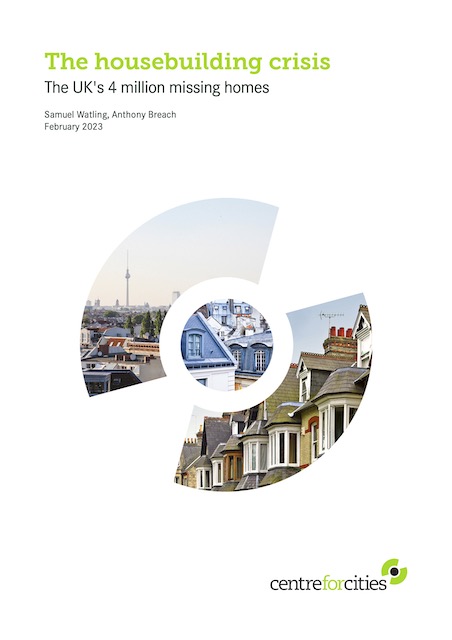The United Kingdom has some of the least affordable housing of any country in the world, with median homes costing more than five times median incomes. In the United States, only California and Hawaii have less affordable housing. A new report estimates that the U.K. needs 4.3 million homes to restore affordability, but the country’s planning system prevents those homes from being built.
 Click image to download a 5.1-MB PDF of this 65-page report.
Click image to download a 5.1-MB PDF of this 65-page report.
The report, which is published by a think tank called Centre for Cities, correctly places the blame for the state of the country’s housing on the Town & Country Planning Act of 1947. This law took away development rights from every private landowner in the country and only allowed new development if it complied with local and regional land-use plans.
All of the cities in the United Kingdom cover about 6 percent of the nation’s land area. The Town & Country Planning Act put greenbelts around those cities that cover 12 percent of the land. Since that law, subsequent laws have put in more restrictions for historic, environmental, and other reasons, until very little of the 94 percent of rural land is available for development.
Initially, the country increased housing by clearing areas bombed during the war and other “slums” and replacing them with high-rise housing. For several years after the war, almost no new private housing was built; it was all “council housing,” meaning government-owned housing. Not only was this less desirable to many than single-family homes, tthe quality of that housing was often poor.
Eventually, the private homebuilding industry recovered, but private builders could never build affordable housing in the U.K. they way they can in many U.S. states, which is by acquiring and subdividing large blocks of land and then building large numbers of homes at one time. Instead, most new private homes were one-offs or built in very small numbers.
The report makes it sound like other European countries are better off than the U.K. in this regard. But most of those countries were inspire by the Town & Country Act to pass their own laws restricting rural development. Also, in many of the countries, most rural land is owned by a small aristocracy. I don’t know of any country in Europe where a developer could buy, say, 100 hectares (about 220 acres), subdivide it into tenth-hectare lots (about 9,000 square feet), and built 800 homes (leaving 20 percent for streets), yet such developments are routine in most U.S. states that haven’t passed growth-management laws.
To fix the problem, the report recommends replacing the Town & Country Planning Act with a zoning system similar to that used in the United States. But that system hasn’t worked all that well in California, Oregon, Washington, and some other states.
What is really needed is to open up greenfields outside of cities to new development. The best way to do this is to abolish rural zoning and allow developers to build for the market. A nationwide zoning system is not going to fix the problems since it will continue to allow central planners to decide what combination of single- and multifamily housing should be built.
Planners, most of whom live in single-family homes themselves (at least in the U.S.), prefer multifamily housing for other people. That just makes the single-family housing that most people (in just about every country) prefer more expensive.
The United Kingdom has slightly less land than the state of Oregon but 16 times as many people. If the greenbelts were opened for development, then 18 percent of the nation’s land would be urban and housing would be far ore affordable. Yet 82 percent of land would still be available for farms, forests, and other rural uses.
The U.K. parliament needs to do more than just tinker with the Town & Country Planning Act as recommended in this report. It needs to repeal that law and start over recognizing that people’s preferences for the kind of homes they would to live in should take priority over the kinds of homes planners want to build for them.








82 percent for “farms and forests” sounds nice but if you’re talking about the UK, I assume that includes Scotland, which has a relatively low population density. Any visitor to southern England must surely be amazed by the tracts of housing that have already consumed former farmland around every small town or village. In a small nation that grows insufficient food to feed its population, the real problem is too many people.